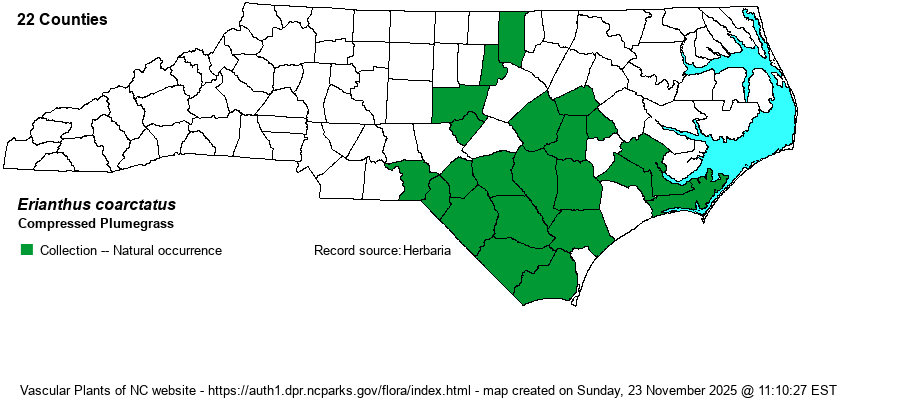| Section 5 » Family Poaceae |
Show/Hide Synonym
| taxonName | relationship | relatedTaxonName | relatedTaxonRefText | relComments |
|---|
|
| Erianthus coarctatus | < | Erianthus brevibarbis | Gleason and Cronquist (1991) | | | Erianthus coarctatus | < | Erianthus brevibarbis | Gleason (1952) | | | Erianthus coarctatus | < | Erianthus brevibarbis | Godfrey and Wooten (1979, 1981) | | | Erianthus coarctatus | < | Erianthus brevibarbis | Radford, Ahles, and Bell (1968) | | | Erianthus coarctatus | < | Erianthus brevibarbis | Small (1933, 1938) | | | Erianthus coarctatus | = | Saccharum coarctatum | Flora of North America (1993b, 1997, 2000, 2002a, 2002b, 2003a, 2004b, 2005, 2006a, 2006b, 2006c, 2007a, 2009, 2010) | | | Erianthus coarctatus | = | Saccharum coarctatum | | | | Erianthus coarctatus | = | Saccharum coarctatum | Flora of Virginia | | | Erianthus coarctatus | = | Saccharum coarctatum | Wunderlin & Hansen Flora of Florida (3) | | | Erianthus coarctatus | = | Saccharum coarctatum | Hodkinson et al. (2002). [also see Tripidium] | | | Erianthus coarctatus | >< | Erianthus coarctatus var. coarctatus | Hitchcock & Chase (Manual of US Grasses) | | | Erianthus coarctatus | >< | Erianthus coarctatus var. elliottianus | Hitchcock & Chase (Manual of US Grasses) | | | Source: Weakley's Flora |
|
| Author | Fernald | |
| Distribution | Mostly the southern 2/3 of the Coastal Plain. All specimens from the Piedmont need their identifications checked; most likely they are E. contortus.
Coastal Plain, DE to northern FL to eastern TX. | |
| Abundance | Fairly common to frequent in much of the southern Coastal Plain, but uncommon into the central Coastal Plain and edge of the Piedmont (if correctly identified there). The website editors give a State Rank of S4?. | |
| Habitat | Freshwater marshes, margins of streams, seepage bogs, wet pine savannas, powerlines, wet roadside ditches. | |
| Phenology | Flowering and fruiting September-October. | |
| Identification | In this species, the stems below the inflorescence are glabrous. The awn of the lemma of the upper floret is basally rounded in cross-section and not spiraled (vs. flattened basally and contorted in E. contortus and E. brevibarbis). | |
| Taxonomic Comments | Some references merge or split this species and E. brevibarbis, or at least confuse the two. Many records in SERNEC are listed as E. brevibarbis var. coarctata, for example. Also, some references list the species as Saccharum coarctatum.
Plumegrasses are among our tallest grasses; several species reach 7-8 feet tall. The narrowly to broadly elliptical inflorescences stand erect well beyond the long, arching leaves. For proper ID, it is best to use mature spikelets. When immature, the inflorescences are tightly compact and slender; when mature, they relax and become elliptical in outline, and individual spikelets can be seen. Do not confuse these natives with the alien invasive Phragmites australis, which has much broader leaves and whose inflorescence branches are mostly swept to one side. | |
| Other Common Name(s) | Brown Plumegrass, Bunched Plumegrass | |
| State Rank | [S4?] | |
| Global Rank | G5? | |
| State Status | | |
| US Status | | |
| USACE-agcp | | |
| USACE-emp | | |

